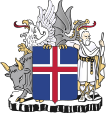| |||||||||||||||||||||||||||||||||||||||||||||
All 63 seats in the Althing 32 seats needed for a majority | |||||||||||||||||||||||||||||||||||||||||||||
| Turnout | 79.18% | ||||||||||||||||||||||||||||||||||||||||||||
|---|---|---|---|---|---|---|---|---|---|---|---|---|---|---|---|---|---|---|---|---|---|---|---|---|---|---|---|---|---|---|---|---|---|---|---|---|---|---|---|---|---|---|---|---|---|
This lists parties that won seats. See the complete results below.
| |||||||||||||||||||||||||||||||||||||||||||||
 |
|---|
|
|
Parliamentary elections were held in Iceland on 29 October 2016. They were due to be held on or before 27 April 2017, but following the 2016 Icelandic anti-government protests, the ruling coalition announced that early elections would be held "in autumn".[1][2]
The Independence Party emerged as the largest in the Althing, winning 21 of the 63 seats; the Progressive Party, which had won the most seats in 2013, lost more than half its seats as it was overtaken by the Left-Green Movement and the Pirate Party. Of the 63 elected MPs, 30 were female, giving Iceland the highest proportion of female MPs in Europe.[3]
A new coalition was formed on 10 January 2017, consisting of the Independence Party, the Reform Party and Bright Future, with Bjarni Benediktsson becoming Prime Minister on 11 January 2017.[4]
Cite error: There are <ref group=n> tags on this page, but the references will not show without a {{reflist|group=n}} template (see the help page).
- ^ Kosningar í haust - Lilja verður ráðherra Archived 2016-08-08 at the Wayback Machine RÚV, 6 April 2016
- ^ Cite error: The named reference
bodawas invoked but never defined (see the help page). - ^ Iceland elections leave ruling centre-right party in driving seat Archived 2016-10-30 at the Wayback Machine The Guardian, 30 October 2016
- ^ Arnarsdóttir, Eygló Svala (9 January 2017). "New Government Announced Tomorrow". Iceland Review. Archived from the original on 10 January 2017. Retrieved 10 January 2017.